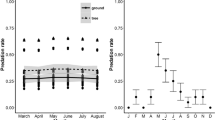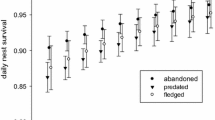Abstract
Rates of nest predation have frequently been shown to differ between fragmented and unfragmented habitats, but have rarely been compared among natural habitats in the same geographic region. In this study, artificial nests of two types (open cup and domed) were placed in four habitats (mangroves, monsoon rainforests, eucalypt woodlands and paperbark swamps) over 12 months in three localities near Darwin in the Australian monsoon tropics to determine the effects of habitat, season and nest type on the rate of nest predation. A quail egg and a similarly coloured plasticine egg were placed in each nest. Habitat had a strong effect on nest predation rates, with nests in mangroves experiencing predation rates more than four times higher than those in eucalypt woodlands and paperbark swamps. Despite the strong rainfall seasonality of the region, there was no consistent seasonal variation in nest predation rates. Nest type also had little influence on predation rates, except in paperbark swamps where open cup nests suffered a higher predation rate than domed nests. The study indicates that generalised nest predation rates for tropical regions, even for small areas (e.g. <17 km radius), might overlook substantial variation between habitats. Such variation confounds purported differences in nest predation rates between tropical and temperate regions.


Similar content being viewed by others
References
Angelstam P (1986) Predation on ground-nesting birds’ nests in relation to predator densities and habitat edge. Oikos 47:365–373
Bayne EM, Hobson KA, Fargey P (1997) Predation on artificial nests in relation to forest type: contrasting the use of quail and plasticine eggs. Ecography 20:233–239
Berry L (2002) Predation rates of artificial nests in the edge and interior of a southern Victorian forest. Wildl Res 29:341–345
Berry L, Lill A (2003) Do predation rates on artificial nests accurately predict predation rates on natural nests. The effects of nest type, egg type and nest site characteristics. Emu 103:207–214
Bosque C, Bosque MT (1995) Nest predation as a selective factor in the evolution of developmental rates in altricial birds. Am Nat 145:234–260
Brown GP, Shine R, Madsen T (2002) Responses of three sympatric snake species to tropical seasonality in northern Australia. J Trop Ecol 18:549–568
Burnham KP, Anderson DR (2002) Model selection and multimodel inference: a practical information-theoretic approach. Springer, New York
Christian KA, Corbett LK, Green B, Weavers BW (1995) Seasonal activity and energetics of two species of varanid lizards in tropical Australia. Oecologia 103:349–357
Collias NE, Collias EC (1984) Nest building and bird behaviour. Princeton University Press, Princeton, NJ
Edwards A, Hauser P, Anderson M, McCartney J, Armstrong M, Thackway R, Allan G, Hempel C, Russell-Smith J (2001) A tale of two parks: contemporary fire regimes of Litchfield and Nitmiluk National Parks, monsoonal northern Australia. Int J Wild Fire 10:79–89
Ford HA, Tremont S (2000) Life history characteristics of two Australian honeyeaters (Meliphagidae). Aust J Zool 48:21–32
Frith CB, Frith DW, Jansen A (1997) The nesting biology of the Chowchilla Orthonyx spaldingii (Orthonychidae). Emu 97:18–30
Fulton GR, Ford HA (2001) The Pied Currawong’s role in avian nest predation: a predator removal experiment. Pac Conserv Biol 7:154–160
Fulton GR, Ford HA (2003) Quail eggs, modelling clay eggs, imprints and small mammals in an Australian woodland. Emu 103:255–258
Gardner JL (1998) Experimental evidence for edge-related predation in a fragmented agricultural landscape. Aust J Ecol 23:311–321
George TL (1987) Greater land bird densities on island vs mainland: relation to nest predation level. Ecology 68:1393–1400
Gibbs JP (1991) Avian nest predation in tropical wet forest: an experimental study. Oikos 60:155–161
Haskell DG (1995) Forest fragmentation and nest predation: are experiments with Japanese Quail eggs misleading? Auk 112:767–770
Hausmann F, Catterall CP, Piper SD (2004) Effects of edge habitat and nest site characteristics on depredation of artificial nests in fragmented Australian tropical rainforest. Biodivers Conserv 14:2331–2345
Hillborn R, Mangel M (1997) The ecological detective confronting models with data. Princeton University Press, NJ
Janzen DH (1978) Predation intensity on eggs on the ground in two Costa Rican forests. Am Mid Nat 100:467–470
King DI, DeGraaf RM, Griffin CR, Maier TJ (1999) Do predation rates on artificial nests accurately reflect predation rates on natural bird nests? J Field Orn 70:257–262
Laurance WF, Grant JD (1994) Photographic identification of ground-nest predators in Australian tropical rainforests. Wildl Res 21:241–248
Laurance WF, Garesche J, Payne W (1993) Avian nest predation in modified and natural habitats in tropical Queensland: an experimental study. Wildl Res 20:711–723
Larivière S (1999) Reasons why predators cannot be inferred from nest remains. Condor 101:718–721
Lindsey JK (1999) Models for repeated measurements, 2nd edn. Oxford University Press, Oxford
Loiselle BA, Hoppes WG (1983) Nest predation in insular and mainland lowland rain forest in Panama. Condor 85:93–95
Major RE, Christie FJ, Gowing G, Ivison TJ (1999) Elevated rates of predation on artificial nests in linear strips of habitat. J Field Orn 70:351–364
Major RE, Gowing G, Kendal CE (1996) Nest predation in Australian urban environments and the role of the pied currawong, Strepera graculina. Aust J Ecol 21:399–409
Major RE, Kendal CE (1996) The contribution of artificial nest experiments to understanding avian reproductive success: a review of methods and conclusions. Ibis 138:298–307
Major RE, Pyke GH, Christy MT, Gowling G, Hill RS (1994) Can nest predation explain the timing of the breeding season and the pattern of nest dispersion of New Holland Honeyeaters? Oikos 69:364–372
Marini MA, Melo C (1998) Predators of quail eggs, and the evidence of the remains: implications for nest predation studies. Condor 100:395–399
Martin TE (1987) Artificial nest experiments: effects of nest appearance and type of predator. Condor 89:925–928
Martin TE (1993) Nest predation and nest sites: new perspectives on old patterns. Bioscience 43:523–532
Martin TE (2002) A new view of avian life-history evolution tested on an incubation paradox. Proc R Soc Lond B 269:309–316
Martin TE, Li P (1992) Life history traits of open- vs cavity-nesting birds. Ecology 73:579–592
Martin TE, Scott J, Menge C (2000) Nest predation increases with parental activity: separating nest site and parental activity effects. Proc R Soc Lond B 267:2287–2293
Mayfield HF (1975) Suggestions for calculating nest success. Wilson Bull 87:456–466
Mulyani Y (2004) Reproductive ecology of tropical mangrove-dwelling warblers: the roles of nest predation, brood parasitism and food limitation. Ph.D. thesis, Charles Darwin University, Darwin
Noske RA (1998) Breeding biology, demography and success of the Rufous-banded Honeyeater Conopophila albogularis in Darwin, a monsoonal tropical city. Wildl Res 25:339–356
Noske RA (1999) Notes on the breeding biology of the tropical mangrove-dwelling Yellow White-eye Zosterops luteus. Aust Bird Watcher 18:3–7
Noske RA (2001) The breeding biology of the Mangrove Gerygone Gerygone laevigaster in the Darwin region, with notes on brood parasitism by the Little Bronze-cuckoo Chrysococcyx minutillis. Emu 101:129–135
Noske RA, Franklin DC (1999) Breeding seasons of land birds in the Australian monsoon tropics: diverse responses to a highly seasonal environment. Aust Biol 12:72–90
Oniki Y (1979) Is nesting success of birds low in the tropics? Biotrop 11:60–69
Ortega CP, Ortega JC, Rapp C, Backensto SA (1998) Validating the use of artificial nests in predation experiments. J Wildl Manage 62:925–932
Pärt T, Wretenberg J (2002) Do artificial nests reveal relative nest predation risk for real nests? J Avian Biol 33:39–46
Pinheiro JC, Bates DM (2000) Mixed-effects models in S and S-PLUS. Springer, New York
Rangen SA, Clark RG, Hobson KA (2000) Visual and olfactory attributes of artificial nests. Auk 117:136–146
Ricklefs RE (1969) The nesting cycle of songbirds in tropical and temperate regions. Living Bird 8:165–175
Robinson D (1990) The nesting ecology of sympatric Scarlet Robin Petroica multicolor and Flame Robin P. phoenicea in open eucalyptus forest. Emu 90:40–52
Robinson WD, Robinson TR, Robinson SK, Brawn JD (2000) Nesting success of understory forest birds in central Panama. J Avian Biol 31:151–164
Roper JJ (1992) Nest predation experiments with quail eggs: too much to swallow? Oikos 65:528–530
Roper JJ (2003) Nest-sites influence nest predation differently at natural and experimental nests. Orn Neotrop 14:1–14
Savidge JA, Seibert TF (1988) An infrared trigger and camera to identify predators at artificial nests. J Wildl Manage 52:291–294
Semenuik V (1985) Mangrove environments of Port Darwin, Northern Territory: the physical framework and habitats. J R Soc West Aust 67:81–97
Shine R (1991) Australian snakes: a natural history. Reed Books, Balgowlah, NSW, Australia
Skutch AF (1966) A breeding bird census and nesting success in Central America. Ibis 108:1–16
Slagsvold T (1982) Clutch size variation in tropical birds: the nest predation hypothesis. Oecologia 54:159–169
Söderström B (1999) Artificial nest predation rates in tropical and temperate forests: a review of the effects of edge and nest site. Ecography 22:455–463
Stutchbury BJM, Morton ES (2001) Behavioural ecology of tropical birds. Academic, San Diego, CA
Taylor JA, Tulloch D (1985) Rainfall in the wet-dry tropics: extreme events at Darwin and similarities between years during period, 1870–1983 inclusive. Aust J Ecol 10:281–295
Taylor LNH, Ford HA (1998) Predation of artificial nests in a fragmented landscape on the New England Tablelands of New South Wales. Wildl Res 25:587–594
Weidinger K (2002) Interactive effects of concealment, parental behaviour and predators on the survival of open passerine nests. J Anim Ecol 71:424–437
Whelan CJ, Dilger ML, Robson D, Hallyn N, Dilger S (1994) Effects of olfactory cues on artificial-nest experiments. Auk 111:945–952
Wightman GM (1989) Mangroves of the Northern Territory. Conservation Commission of the Northern Territory, Darwin, Australia
Willebrand T, Marcström V (1988) On the danger of using dummy nests to study predation. Auk 105:378–379
Wilson BA, Bowman DMJS (1987) Fire, storm, flood and drought: the vegetation ecology of Howard’s Peninsula, Northern Territory, Australia. Aust J Ecol 12:165–174
Wilson BA, Brocklehurst PS, Clark MJ, Dickinson KJM (1990) Vegetation survey of the Northern Territory, Australia. Technical report No. 49. Conservation Commission of the Northern Territory, Darwin, Australia
Wilson GR, Brittingham MC, Goodrich LJ (1998) How well do artificial nests estimate success of real nests? Condor 100:357–364
Woinarski JCZ, Tidemann SC, Kerin S (1988) Birds in a tropical mosaic: the distribution of bird species in relation to vegetation patterns. Aust Wildl Res 15:171–196
Yahner RH, Morrell TE, Rachael JS (1989) Effects of edge contrast on depredation of artificial avian nests. J Wildl Manage 53:1135–1138
Zanette L (2002) What do artificial nests tell us about nest predation? Biol Conserv 103:323–329
Zanette L, Jenkins B (2000) Nesting success and nest predators in forest fragments: a study using real and artificial nests. Auk 117:445–454
Zimmermann UM (1996) Ecology of the monsoon-rainforest endemic Rainbow Pitta Pitta iris. Ph.D. thesis, Northern Territory University, Darwin
Zimmermann UM, Noske RA (2003) Breeding biology of the rainbow pitta Pitta iris, a species endemic to Australian monsoon-tropical rainforests. Emu 103:245–254
Acknowledgements
The fieldwork for this study was conducted by SF as part of her B.Sc. Honours at Charles Darwin University (formerly Northern Territory University). We thank Peter Whitehead, Key Centre of Tropical Wildlife Management, for financial support. SF thanks Robert and Yvonne Fischer, Julie Marriott, Peter Phillpott, Rosalinda Isorena, Mike Bellamy, Philip McMahon, Bineeta Sharma and all Library staff at CDU for their support over the 2 years of the project. The Parks and Wildlife Commission of the Northern Territory gave permission to work in the Territory Wildlife Park, Howard Springs and Holmes Jungle, and we thanks the staff in these Parks, especially Brian Delaney and Jasmine Jan. We extend our sincere thanks to Pacific Dunlop, Australia, for their donation of 300 tennis balls. Quail eggs were supplied by The Game Farm, NSW. Finally we thank Hugh Ford and an anonymous referee for helpful comments on an earlier version of this manuscript.
Author information
Authors and Affiliations
Corresponding author
About this article
Cite this article
Noske, R.A., Fischer, S. & Brook, B.W. Artificial nest predation rates vary among habitats in the Australian monsoon tropics. Ecol Res 23, 519–527 (2008). https://doi.org/10.1007/s11284-007-0403-y
Received:
Accepted:
Published:
Issue Date:
DOI: https://doi.org/10.1007/s11284-007-0403-y




